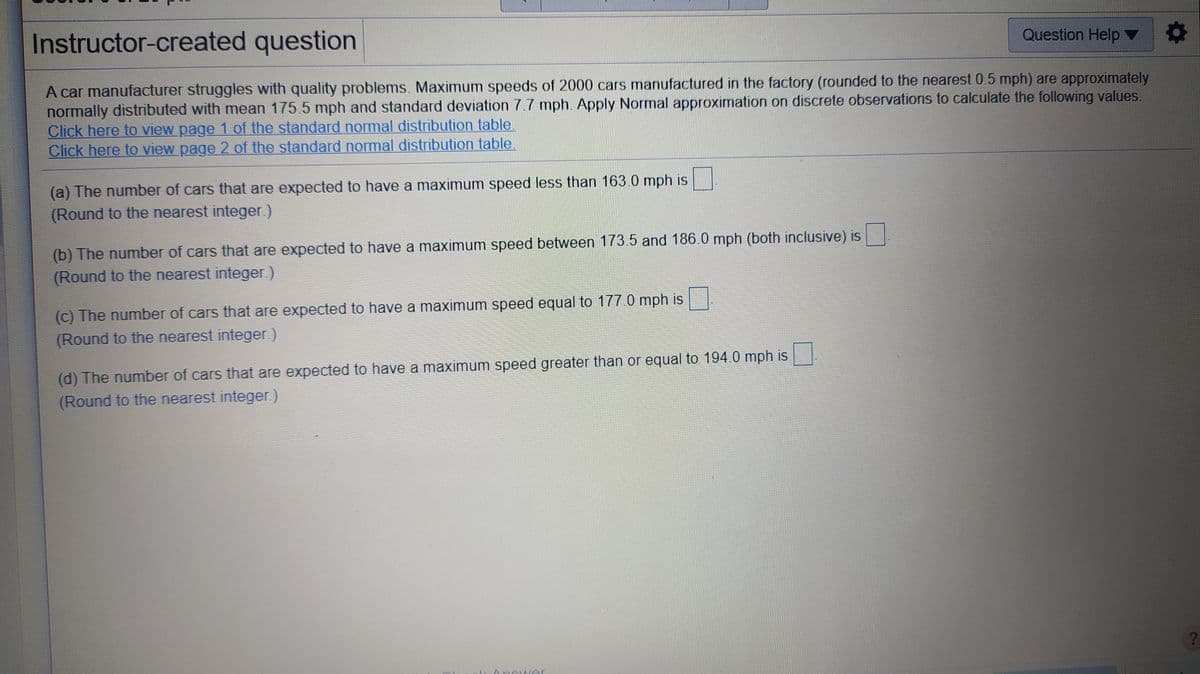Instructor-created question Question Help ▼ A car manufacturer struggles with quality problems. Maximum speeds of 2000 cars manufactured in the factory (rounded to the nearest 0.5 mph) are approximately normally distributed with mean 175.5 mph and standard deviation 7.7 mph. Apply Normal approximation on discrete observations to calculate the following values. Click here to view page 1 of the standard normal distribution table Click here to view page 2 of the standard normal distribution table. (a) The number of cars that are expected to have a maximum speed less than 163.0 mph is (Round to the nearest integer.) (b) The number of cars that are expected to have a maximum speed between 173.5 and 186.0 mph (both inclusive) is (Round to the nearest integer ) (c) The number of cars that are expected to have a maximum speed equal to 177.0 mph is (Round to the nearest integer.) (d) The number of cars that are expected to have a maximum speed greater than or equal to 194.0 mph is (Round to the nearest integer.)
Instructor-created question Question Help ▼ A car manufacturer struggles with quality problems. Maximum speeds of 2000 cars manufactured in the factory (rounded to the nearest 0.5 mph) are approximately normally distributed with mean 175.5 mph and standard deviation 7.7 mph. Apply Normal approximation on discrete observations to calculate the following values. Click here to view page 1 of the standard normal distribution table Click here to view page 2 of the standard normal distribution table. (a) The number of cars that are expected to have a maximum speed less than 163.0 mph is (Round to the nearest integer.) (b) The number of cars that are expected to have a maximum speed between 173.5 and 186.0 mph (both inclusive) is (Round to the nearest integer ) (c) The number of cars that are expected to have a maximum speed equal to 177.0 mph is (Round to the nearest integer.) (d) The number of cars that are expected to have a maximum speed greater than or equal to 194.0 mph is (Round to the nearest integer.)
Glencoe Algebra 1, Student Edition, 9780079039897, 0079039898, 2018
18th Edition
ISBN:9780079039897
Author:Carter
Publisher:Carter
Chapter10: Statistics
Section: Chapter Questions
Problem 22SGR
Related questions
Topic Video
Question

Transcribed Image Text:Instructor-created question
Question Help ▼
A car manufacturer struggles with quality problems. Maximum speeds of 2000 cars manufactured in the factory (rounded to the nearest 0.5 mph) are approximately
normally distributed with mean 175.5 mph and standard deviation 7.7 mph. Apply Normal approximation on discrete observations to calculate the following values.
Click here to view page 1 of the standard normal distribution table.
Click here to view page 2 of the standard normal distribution table.
(a) The number of cars that are expected to have a maximum speed less than 163.0 mph is
(Round to the nearest integer.)
(b) The number of cars that are expected to have a maximum speed between 173.5 and 186.0 mph (both inclusive) is
(Round to the nearest integer)
(c) The number of cars that are expected to have a maximum speed equal to 177.0 mph is
(Round to the nearest integer.)
(d) The number of cars that are expected to have a maximum speed greater than or equal to 194.0 mph is
(Round to the nearest integer)
Ancwer
Expert Solution
This question has been solved!
Explore an expertly crafted, step-by-step solution for a thorough understanding of key concepts.
Step by step
Solved in 3 steps with 2 images

Knowledge Booster
Learn more about
Need a deep-dive on the concept behind this application? Look no further. Learn more about this topic, probability and related others by exploring similar questions and additional content below.Recommended textbooks for you

Glencoe Algebra 1, Student Edition, 9780079039897…
Algebra
ISBN:
9780079039897
Author:
Carter
Publisher:
McGraw Hill

Glencoe Algebra 1, Student Edition, 9780079039897…
Algebra
ISBN:
9780079039897
Author:
Carter
Publisher:
McGraw Hill